Babak Nouri-Moghaddam
Hybrid stacked ensemble combined with genetic algorithms for Prediction of Diabetes
Mar 15, 2021



Abstract:Diabetes is currently one of the most common, dangerous, and costly diseases in the world that is caused by an increase in blood sugar or a decrease in insulin in the body. Diabetes can have detrimental effects on people's health if diagnosed late. Today, diabetes has become one of the challenges for health and government officials. Prevention is a priority, and taking care of people's health without compromising their comfort is an essential need. In this study, the Ensemble training methodology based on genetic algorithms are used to accurately diagnose and predict the outcomes of diabetes mellitus. In this study, we use the experimental data, real data on Indian diabetics on the University of California website. Current developments in ICT, such as the Internet of Things, machine learning, and data mining, allow us to provide health strategies with more intelligent capabilities to accurately predict the outcomes of the disease in daily life and the hospital and prevent the progression of this disease and its many complications. The results show the high performance of the proposed method in diagnosing the disease, which has reached 98.8%, and 99% accuracy in this study.
Deep Neural Network Based Ensemble learning Algorithms for the healthcare system (diagnosis of chronic diseases)
Mar 15, 2021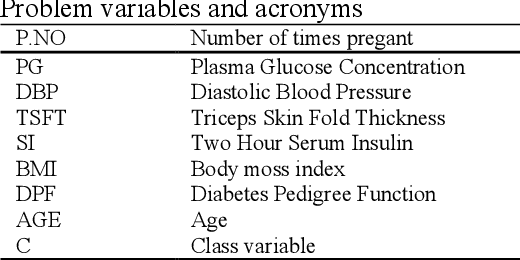
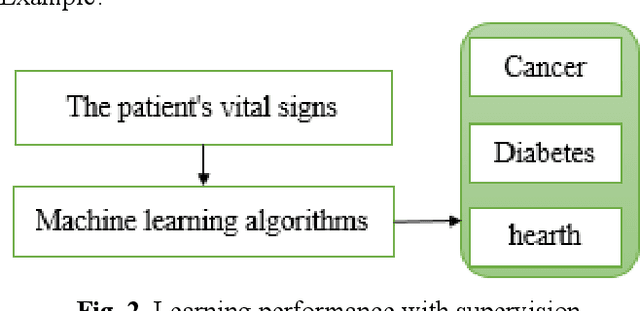

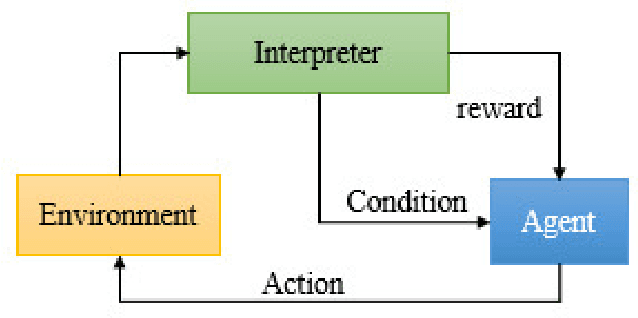
Abstract:learning algorithms. In this paper, we review the classification algorithms used in the health care system (chronic diseases) and present the neural network-based Ensemble learning method. We briefly describe the commonly used algorithms and describe their critical properties. Materials and Methods: In this study, modern classification algorithms used in healthcare, examine the principles of these methods and guidelines, and to accurately diagnose and predict chronic diseases, superior machine learning algorithms with the neural network-based ensemble learning Is used. To do this, we use experimental data, real data on chronic patients (diabetes, heart, cancer) available on the UCI site. Results: We found that group algorithms designed to diagnose chronic diseases can be more effective than baseline algorithms. It also identifies several challenges to further advancing the classification of machine learning in the diagnosis of chronic diseases. Conclusion: The results show the high performance of the neural network-based Ensemble learning approach for the diagnosis and prediction of chronic diseases, which in this study reached 98.5, 99, and 100% accuracy, respectively.
Modeling and forecasting Spread of COVID-19 epidemic in Iran until Sep 22, 2021, based on deep learning
Mar 15, 2021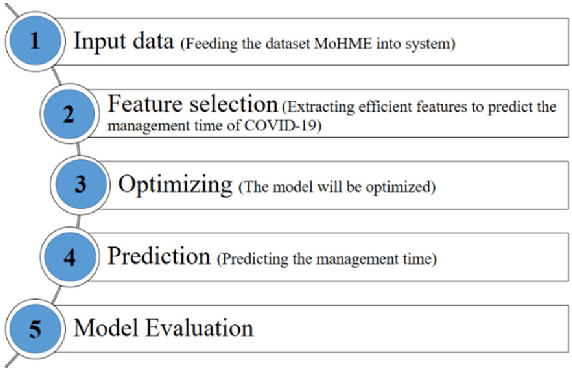


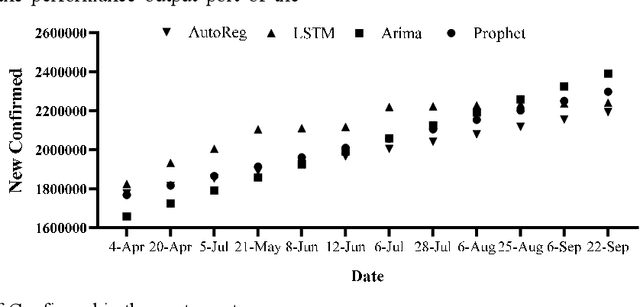
Abstract:The recent global outbreak of covid-19 is affecting many countries around the world. Due to the growing number of newly infected individuals and the health-care system bottlenecks, it will be useful to predict the upcoming number of patients. This study aims to efficiently forecast the is used to estimate new cases, number of deaths, and number of recovered patients in Iran for 180 days, using the official dataset of the Iranian Ministry of Health and Medical Education and the impact of control measures on the spread of COVID-19. Four different types of forecasting techniques, time series, and machine learning algorithms, are developed and the best performing method for the given case study is determined. Under the time series, we consider the four algorithms including Prophet, Long short-term memory, Autoregressive, Autoregressive Integrated Moving Average models. On comparing the different techniques, we found that deep learning methods yield better results than time series forecasting algorithms. More specifically, the least value of the error measures is observed in seasonal ANN and LSTM models. Our findings showed that if precautionary measures are taken seriously, the number of new cases and deaths will decrease, and the number of deaths in September 2021 will reach zero.
Feature selection for medical diagnosis: Evaluation for using a hybrid Stacked-Genetic approach in the diagnosis of heart disease
Mar 15, 2021



Abstract:Background and purpose: Heart disease has been one of the most important causes of death in the last 10 years, so the use of classification methods to diagnose and predict heart disease is very important. If this disease is predicted before menstruation, it is possible to prevent high mortality of the disease and provide more accurate and efficient treatment methods. Materials and Methods: Due to the selection of input features, the use of basic algorithms can be very time-consuming. Reducing dimensions or choosing a good subset of features, without risking accuracy, has great importance for basic algorithms for successful use in the region. In this paper, we propose an ensemble-genetic learning method using wrapper feature reduction to select features in disease classification. Findings: The development of a medical diagnosis system based on ensemble learning to predict heart disease provides a more accurate diagnosis than the traditional method and reduces the cost of treatment. Conclusion: The results showed that Thallium Scan and vascular occlusion were the most important features in the diagnosis of heart disease and can distinguish between sick and healthy people with 97.57% accuracy.
A Novel Bio-Inspired Hybrid Multi-Filter Wrapper Gene Selection Method with Ensemble Classifier for Microarray Data
Jan 04, 2021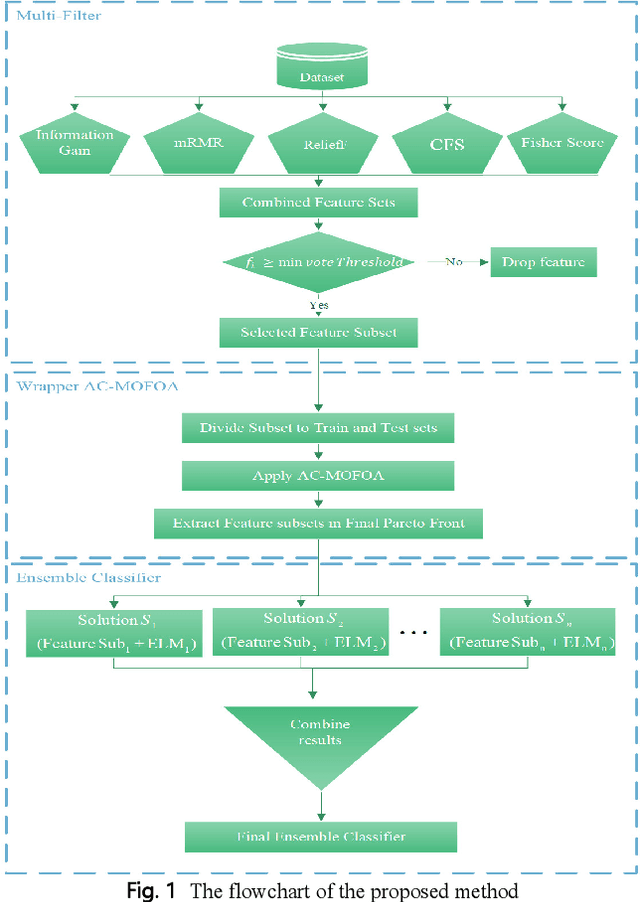
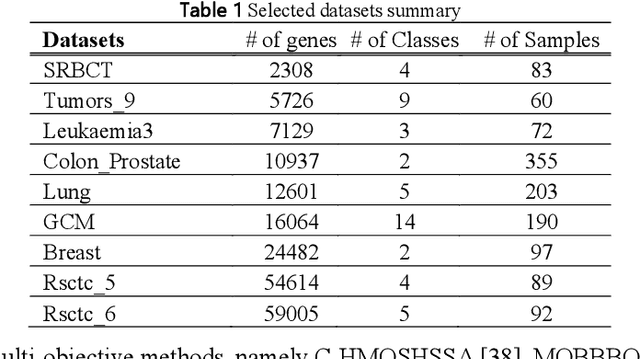

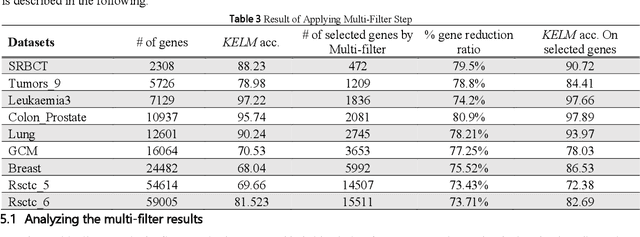
Abstract:Microarray technology is known as one of the most important tools for collecting DNA expression data. This technology allows researchers to investigate and examine types of diseases and their origins. However, microarray data are often associated with challenges such as small sample size, a significant number of genes, imbalanced data, etc. that make classification models inefficient. Thus, a new hybrid solution based on multi-filter and adaptive chaotic multi-objective forest optimization algorithm (AC-MOFOA) is presented to solve the gene selection problem and construct the Ensemble Classifier. In the proposed solution, to reduce the dataset's dimensions, a multi-filter model uses a combination of five filter methods to remove redundant and irrelevant genes. Then, an AC-MOFOA based on the concepts of non-dominated sorting, crowding distance, chaos theory, and adaptive operators is presented. AC-MOFOA as a wrapper method aimed at reducing dataset dimensions, optimizing KELM, and increasing the accuracy of the classification, simultaneously. Next, in this method, an ensemble classifier model is presented using AC-MOFOA results to classify microarray data. The performance of the proposed algorithm was evaluated on nine public microarray datasets, and its results were compared in terms of the number of selected genes, classification efficiency, execution time, time complexity, and hypervolume indicator criterion with five hybrid multi-objective methods. According to the results, the proposed hybrid method could increase the accuracy of the KELM in most datasets by reducing the dataset's dimensions and achieve similar or superior performance compared to other multi-objective methods. Furthermore, the proposed Ensemble Classifier model could provide better classification accuracy and generalizability in microarray data compared to conventional ensemble methods.
 Add to Chrome
Add to Chrome Add to Firefox
Add to Firefox Add to Edge
Add to Edge